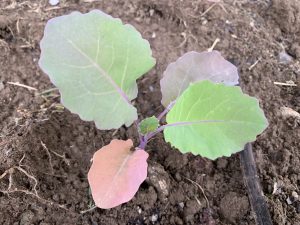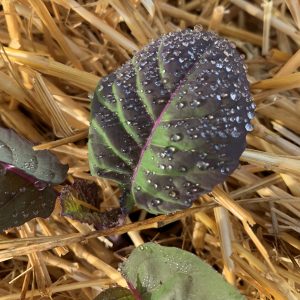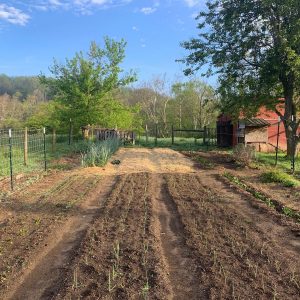What to Do with Blackberry Winters
It’s happening again. The weather has been gorgeous, absolutely gorgeous. In fact, the weather has been so gorgeous that many gardeners have been persuaded to go ahead and plant out their summer crops like peppers, squash, tomatoes, and melons. For the second year in a row, weeks of sun and warmth and all around gorgeousness have tricked us into thinking it wouldn’t get cold again. At least, it wouldn’t get too cold, just manageably cold… right?
Well, it’s getting too cold.
We’re having a Blackberry Winter. According to The Old Farmers Almanac a blackberry winter is “mainly a Southern term used to describe a brief period of cold weather that coincides with the time the blackberries are in bloom, (typically in early to mid-May).” Blackberry winters follow the Dogwood and Redbud winters which come earlier in the year, but are better known for crushing gardeners’ dreams of harvesting summer crops earlier than their neighbors.
A Blackberry Winter seems to come out of nowhere and could dissuade many new gardeners, such as the Victory Gardeners we’re seeing sprouting up across the country, from continuing down their path of self-sufficiency. Don’t be tricked into thinking you “have a black thumb” or “don’t know what you’re doing.”
You do not have a black thumb.
It’s important to accept gardening for what it is — an experiment. There is no predicting the weather and many experienced gardeners across the country hedge their bets that Mother Nature will skip the blackberry winter each year. Don’t stop gambling with your garden plan. While you’re learning the ropes, it’s okay to not hit jackpot. Keep going and you will eventually get that red ripe tomato weeks before your neighbor.
Here are some steps you can take today to save your crops tonight (or this weekend).

Step 1: Know what you have planted. There are crops that can handle a heavy frost, a light frost, and no frost at all.
The following are annual crops that can handle a light frost…
- Beets
- Broccoli
- Brussels sprouts
- Cabbage
- Carrots
- Cauliflower
- Chard
- Collards
- Garlic
- Kale
- Kohlrabi
- Lettuce
- Mustard
- Onions
- Peas
- Potatoes
- Radishes
- Spinach
- Turnips
Here are the annual crops you have to pay extra special attention to during cold temperatures…
- Beans
- Cantaloupes
- Corn
- Cucumbers
- Eggplant
- Okra
- Peppers
- Pumpkins
- Southern peas
- Summer squash
- Sweet potatoes
- Tomatoes
- Watermelons
- Winter squash

Step 2: Know what to do with what you have. Use what you have on hand to keep your crops cozy as we move towards temperatures in the 20s.
- Cool season crops like the first list above won’t need quite as much protection as the warm season crops. They would appreciate a strip of mulch, row cover, plastic, a tarp, sheet, or blanket to insulate the warmth from the soil and keep the frost off their leaves. For the most part, they should be alright. The plants may wilt, but they should recover. If the frost is particularly heavy, their growth may be stunted for a few weeks.
- Warm season crops such as those listed second will need some heavy-duty help. Typically, these plants will have their growth stunted below 45*F and might take weeks to recover, if they recover at all. Bring out the big-guns by rounding up as much as you can to keep these plants frost-free and the soil warm, if possible. If you’re really looking forward to your peppers, you can even fill up old milk jugs with warm water, place them next to your plant, and place a five gallon bucket over them both, making sure to not leave any leaks for warmth to escape. In a contest to find “the most dedicated gardener,” you could even dig up your plants and bring them inside for the weekend. If you’re relying on those plants to feed your family and don’t have many other options, that really could be the safest way to ensure that your warm-season crops are protected.

Step 3: Understand why you’re doing what you’re doing. Most of the methods above (at least those that keep your plants outside) function by insulating your crops. Be aware that covering them with fabric during the coldest part of the day will trap that cold air next to your plant. Leaving them covered as the day warms up may keep that cold air next to your plant. Ideally, you’re aiming to keep as much warmth next to your plant as possible by covering them an hour or so before sunset and uncovering them as the day warms up. These methods are higher maintenance than most summer gardens, but should facilitate an earlier harvest. For many new victory gardeners, this can make a world of difference.
Step 4: What will be will be. If you’ve taken the steps outlined above, you’ve done what you can. Instead of worrying about what you can’t control, study this 2019 publication from Virginia Cooperative Extension detailing recommended planting dates for your USDA Plant Hardiness Zone.
Consider filling out our Victory Gardening Interest Survey if you’re feeling overwhelmed, inspired, or you want a garden and don’t have the means to start. We’ll send you a digital copy of our Introduction to Organic Gardening Manual and work with you one-on-one to ensure your success at any scale.
Chelsea Goulding, Ag Education Program Manager
Appalachian Sustainable Development